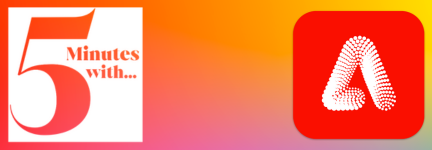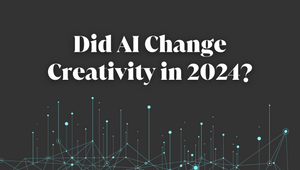
5 Minutes with… Kim Laama

Kim Laama is the global chief creative officer of dotdotdash and TBWA\NEXT. At dotdotdash, Kim and the team are focused on experience innovation; in a nutshell designing digital and physical products, services and spaces that help brands connect with people in new ways. To paraphrase Kim, it’s all about seeing ‘what’s ahead’. “We get particularly excited when we help brands identify new opportunities for disruption,” says Kim.
When it comes to TBWA\NEXT, TBWA’s global innovation practice, Kim is focused on bringing the power of ‘Disruption’ (TBWA’s guiding principle), and limitless creativity to bear in its clients’ news spaces. “In many ways, we’re trying to help shape what the future of creativity can look like for TBWA and our clients which is incredibly exciting,” Kim adds.
Kim joined the TBWA network after two stints as an executive creative director at R/GA and almost 10 years at AKQA with a focus on user experience. LBB’s Addison Capper chats with her about the all-encompassing definition of brand experience, how the agency is elevating accessibility across its design work, and the importance of experimentation.
LBB> dotdotdash builds 'future-forward brand experiences' How do you define brand experiences in today's world where the customer experience is of utmost importance and many campaigns have an 'experience' feel about them?
Kim> ‘Brand experience’ can be hard to define, as it can mean pretty much everything and anything a brand says or does. That’s the beauty of brand experience - it’s all encompassing. But that is also what makes it so hard to pin down. Brand experience is the sentiments, feelings and value that result from the sum of its parts. Brand platforms act as an organising idea to drive the work. Experience is the interconnected set of communications, products, services and interactions that enable the experience.
I love applying human-centred design (HCD) to campaign work - it’s both an art and a science. At TBWA, we bring together epic storytellers and experience designers to create distinct and differentiated brand experiences. We value utility and functionality, but we also want to evoke a positive emotional experience, whether that’s joy, empowerment, belonging, etc. We believe the best campaigns are experiences.
LBB> The earlier days of your career were spent in UX. How does that experience inform the way you manage creative for dotdotdash? What crossover is there with design and innovation within the advertising industry?
Kim> Mastering the experience design craft gave me the confidence to lead work that’s never been done before. And perhaps that’s because ambitious work is always a result of collaboration and teamwork. Both startups and innovation agencies demand adaptability, intensity and a high degree of diplomacy. So I’d say there is quite a bit of crossover in the style of working and expectations in both environments.
These days I focus a lot on designing the experience for our people. Our talent is my design muse. How can I create the best conditions for creativity? How can I bring together complementary talent to create a highly motivated team? How can I foster an inclusive and open environment to exchange ideas and foster learning? I enjoy obsessing over the details of our employee journey and cultivating a work environment that’s centred on our people. I may not be as well-equipped for this stage of my career if I wasn’t an experience designer at heart.
LBB> What aspects of design these days do you get really nerdy about, personally?
Kim> I’ve recently moved to Venice [Beach, California] and am living in an architectural gem – so I’m feeling a great sense of peace and well being, as I design the details within my home environment. Specifically, I’m a major lamp and lighting design nerd. At work, our design team is stoked on spatial audio, 3D design, large-scale content formats and environmental design. We are fascinated by the intersection and architecture of physical and digital spaces. We’re excited about content formats and experience models beyond the 2D desktop and mobile screen paradigm. The industry went abuzz for the metaverse a few years ago – but there are infinite possibilities for experiences that live somewhere in-between pure analogue and completely virtual. That’s where I think we’ll see new and exciting experiences continue to emerge.
LBB> Technology evolves so much and so quickly. How do you keep on top of it? And, as a leader, how do you decide which technologies are worth your teams' and clients' attention when it comes to creative ideas?
Kim> We’ve just launched dits & dahs, a monthly insights newsletter that curates the insights and innovations on the team’s radar. Research and sharing is part of our every day, so I can just be a sponge. When it comes to applying technology to our work, we focus on the problems to solve for the brand, business and consumer. Then we apply the most relevant technology – if it’s feasible – in service of the idea to drive impact and value. Technology is always in service of the brand, business and customer needs.
LBB> How important is time to experiment and prototype for the kind of work you do? How do you foster that?
Kim> Experimenting is a daily habit. We consider it inherent in our way of working. An idea starts as just a thought, then a write-up, then a sketch, then a hi-fidelity comp or interface, then a prototype, etc. We want to see our ideas in action as fast as possible – less talking, more making! We get energy from exploring ideas and getting feedback. We aren’t precious or personal, and we all embrace the iterative approach to making the work. We focus on getting things done, not perfect. That’s not to say we don’t care about craft. We want our ideas to be clear, simple and to connect on an emotional level. Prototypes help us articulate the vision, get authentic feedback, understand the realities of production and build our clients’ confidence that we can collectively deliver impactful work.
LBB> How is AI impacting the kind of work you do at dotdotdash? Both internally and externally in the ideas you're building for clients?
Kim> AI inspires our imagination and has unlocked new creative possibilities. We see AI as a companion or secret weapon in our work. We’ve always been excited about data driven ideas, and it’s great to be in the creative industry while AI is maturing to be more accessible and applicable to even more experience contexts.
AI isn’t quite ubiquitous in our approach yet, but it’s always top of mind. We’re experimenting with things like LoRAs and Stable Diffusion, GPTs, Elevenlabs and interfaces like ComfyUI and Automatic1111. Some of the latest platforms like Humane, Perplexity and Claude 3 provide new perspectives about how AI can integrate into experience driven design. We all like to tinker and share what’s inspiring and useful. With all that said though, we still deeply value the human touch, and the personal design and engineering craft that all our makers bring to the work.
LBB> Accessible design is an increasingly prominent topic - from your experience what are the most challenging facets of accessible design? Is it something that you're thinking about a lot at dotdotdash?
Kim> Our team is well versed in designing and implementing digital experiences that adhere to WCAG (Web Content Accessibility Guidelines) and ADA (Americans with Disabilities Act). Too often, that’s where our accessibility work ends. It’s rare to see work that goes above and beyond this baseline to create new accessible design benchmarks or innovations. The past few years we are starting to see more inspiring work - like Google Project Relate, TBWA’s own LEGO Braille Bricks or the ASDC’s Fingerspelling app. I’d like to see accessible design innovation as a mandatory in more experience briefs. We’ve been inspired by the TBWA\Next Inclusive by Design toolkit, implementing and setting our own new standards for how to elevate accessibility across our work.
Another challenge is that we need more people with disabilities in our industry. We all bring our individual experiences and perspectives to the work, and without that lived experience, we are missing opportunities to bring new insights and generate great ideas. We are just scratching the surface of what accessible experiences should look and feel like. The industry needs to open up to more people with disabilities and design co-creation models that bring diverse experiences into the work.
LBB> More generally, outside of work, what kind of technology and design are you really enjoying right now?
Kim> Outside work, I’m quite lo-fi. I’m enjoying the innovation of the pencil. I love them. I collect them. I draw and write with them. I sharpen them. I put them behind my ear. They make me very happy. They are a perfect design and technology. Don’t ask me to pick a favourite.















